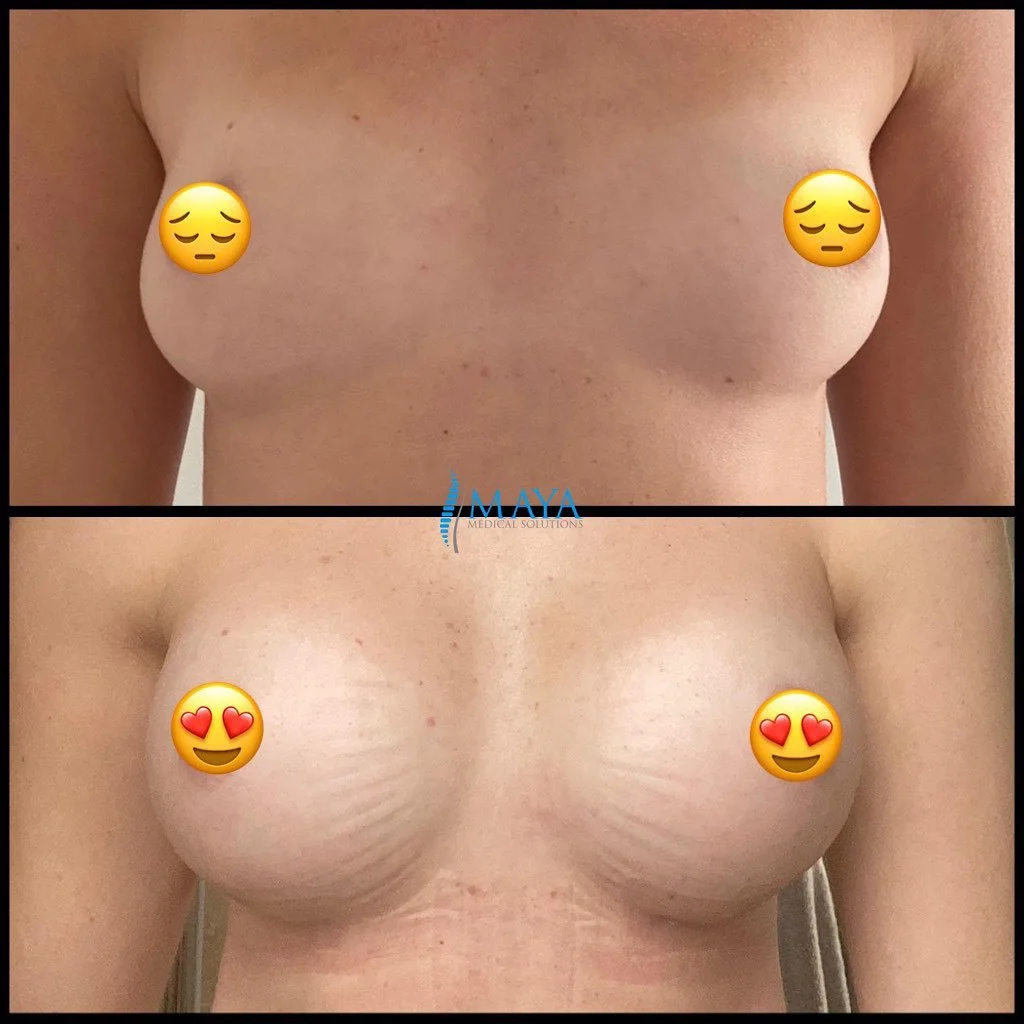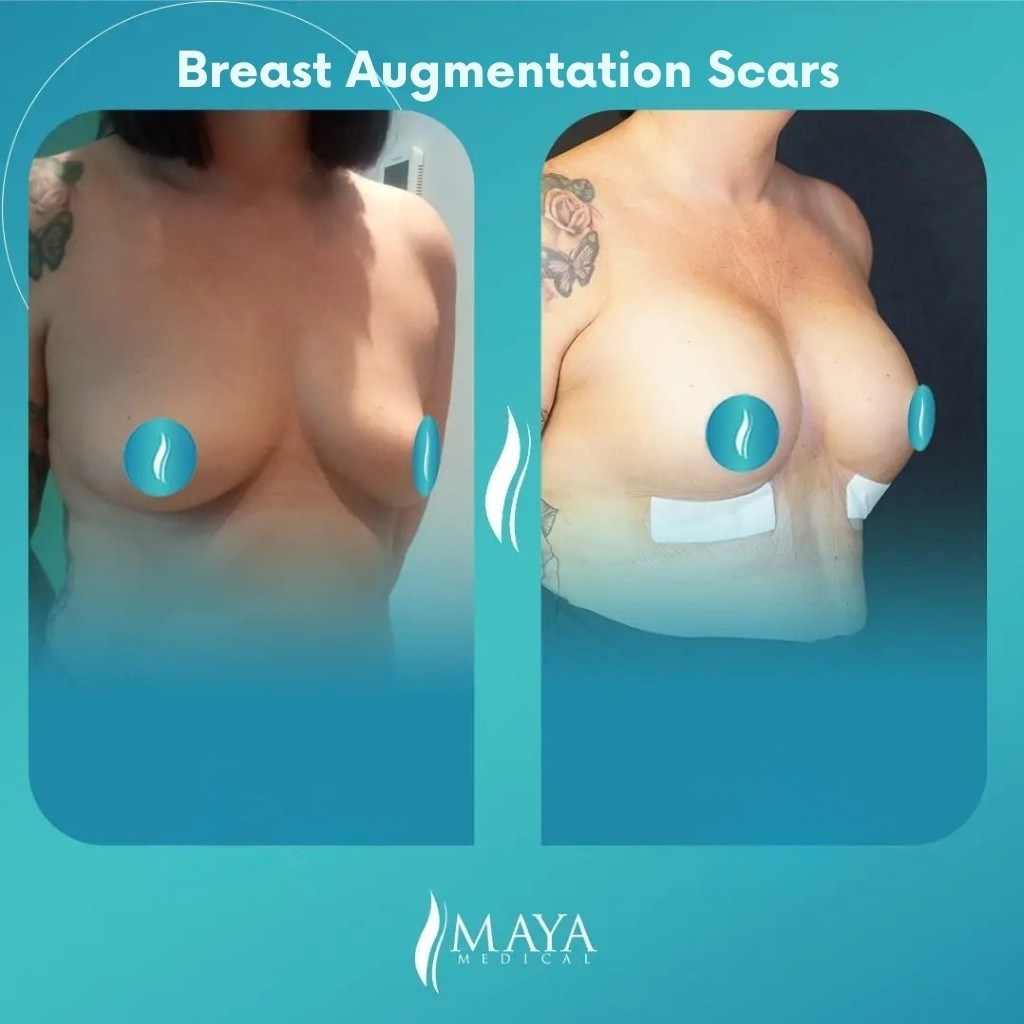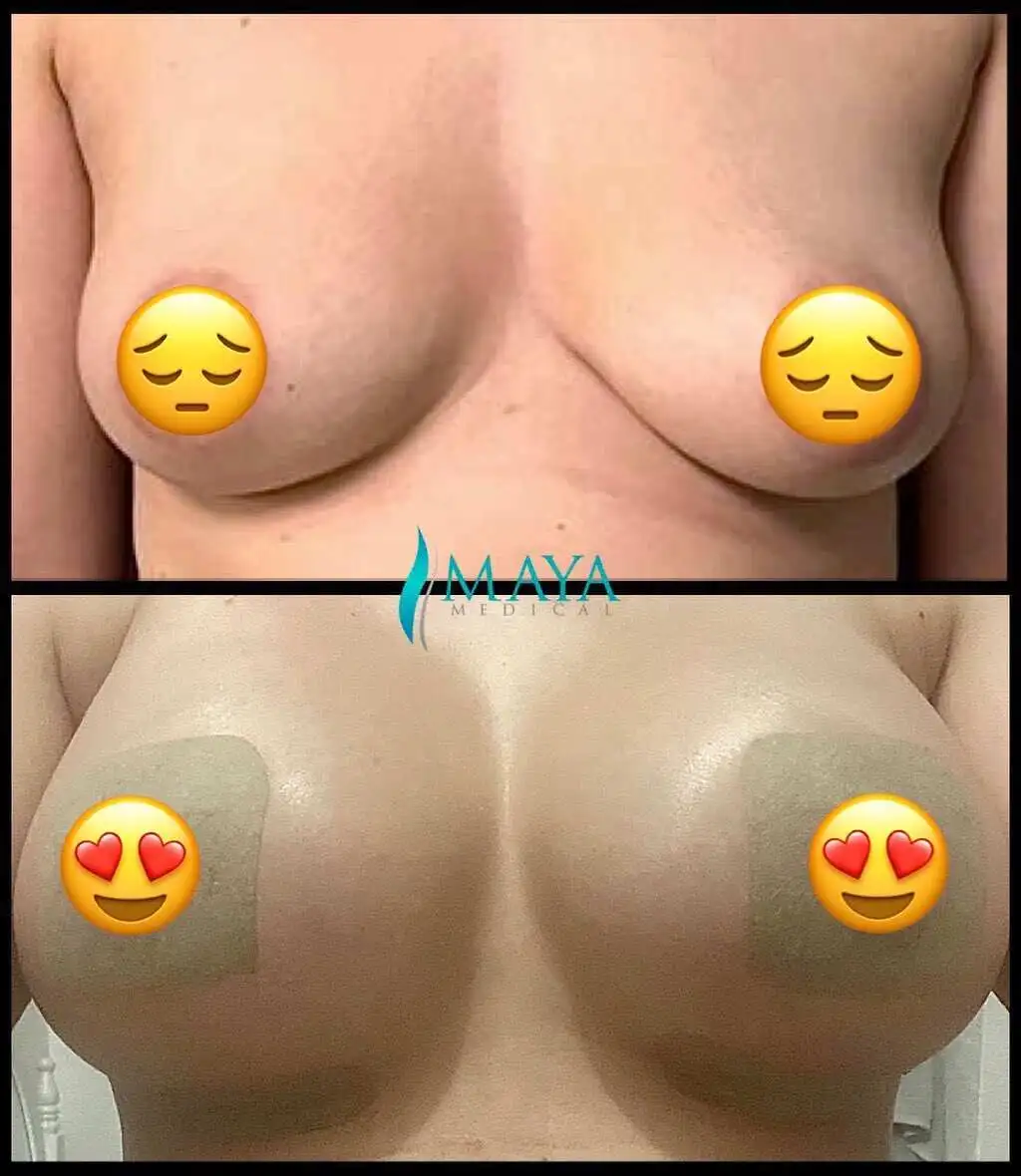Breast augmentation surgery is one of the most common treatments in cosmetic surgery. However, the scars that may occur after surgery and how these scars will look are among the topics that women are most curious about. However, there are many ways to minimize scars and make them almost invisible at our Maya Medical Istanbul aesthetic clinic. In this article, we will discuss the questions about breast augmentation surgery scars and what to do to minimize these scars.
Where are breast augmentation surgery scars?
Scars from breast augmentation and breast implant surgery can usually be found in different areas of the patient depending on the incision technique used by the surgeon. The most common incision areas are the inframammary groove (inframammary incision), around the nipple (periareolar incision), vertical incision under the nipple (lollipop incision), incision under the armpit (transaxillary incision) and incisions made under the belly button.
What do breast augmentation scars look like?
A scar is the healing tissue that forms on the skin after an injury, surgical procedure or disease. As the skin repairs itself, collagen production increases and new tissue forms in the wound area. However, this tissue may be different from the original skin tissue and can sometimes leave distinct scars.

Scars may appear flat, bumpy, sunken or coloured. The final appearance of a scar depends on many factors such as skin type and its location on the body, the direction of the wound, the type of injury, the age and genetic factors of the person with the scar, nutrition and lifestyle.
In the light of this information, predicting how your breast augmentation surgery scar will look will depend on the breast augmentation surgery you will undergo and the incision technique used by your surgeon. It may take approximately 16 – 18 months for the scars to heal completely after breast augmentation surgery. Postoperative scars first appear raised and reddish. Over time, it will turn pink during the healing process and become less noticeable. Eventually, the rough or bumpy appearance in the scar area will flatten and turn into a colour very close to your skin tone.
What are the types of breast augmentation scars?
Breast augmentation surgical scars vary according to the type of porsedure, the incision technique used and the approach applied by the surgeon. Today, there are 4 different incision types used by plastic surgeons in breast augmentation surgeries.
Inframammary incision
One of the most commonly used techniques in breast augmentation surgery is the inframammary incision method. This technique allows the implant to be placed by making a small incision in the lower part of the breast, in the fold where it meets the chest wall. An experienced plastic surgeon positions silicone implants under or above the muscle through the incision, achieving a natural and aesthetic appearance. Even in medium-sized breasts, this incision scar can be easily hidden by the breast crease.

- Advantages of the inframammary incision: The inframammary incision, also known as the breast crease incision, is the most common and reliable breast augmentation incision technique used. Surgeons prefer this technique because it provides greater control during surgery. Many patients prefer it because the scars can be easily hidden. In addition, this technique does not affect nipple sensation and there are no breastfeeding complications after surgery. In addition, this incision technique approach can be used in the person’s subsequent breast surgeries, as needed.
- Disadvantages of the inframammary incision: The biggest downside of this type of incision is that the scar is visible, especially when you lie down or in a supine position.

Periareolar incision
The periareolar incision technique is made between the areola, the dark skin surrounding the nipple, and the surrounding skin of the breast. The resulting scar from breast augmentation surgery can be the entire areola or a semicircular scar around the lower half (periareolar). The implants are placed through this incision into the breast.
- Advantages of the periareolar incision: The benefits of this type of approach are many: the openings are usually small and heal well, creating a well-concealed or nearly invisible scar that blends in with the color and texture variations of the nipple. Any remaining scar tissue is visible only without clothing. In addition, because of the central location, the surgeon can easily and precisely position each implant during surgery to place it in the most attractive location. Finally, future breast surgeries can be performed through the same opening.
- Disadvantages of the periareolar incision: Despite the many benefits of the periareolar approach, there are also some disadvantages. First, it is not suitable for women with very small nipples. Additionally, since the surgery affects the milk ducts in both breasts, it can cause breastfeeding problems for women who want to breastfeed in the future. In addition, since the incision affects the nerves in the nipple, it can cause decreased nipple sensation. In the unlikely event that the scar does not heal properly, it may become raised, lighter in color, or quite visible. This will require a second corrective surgery.
Transaxillary incision
Breast augmentation surgery is performed in the armpit area in the transaxillary incision, which is why it is also known as the armpit incision. Although this type of incision is optimally useful for hiding surgical scars, the surgeon cannot comfortably place breast implants and restricts the range of motion. This technique is not a popular and highly sought-after technique. Only patients who do not want any scars in the chest area prefer this technique.
- Advantages of the transaxillary incision: Since the surgery is performed without touching the breasts in this type of incision, the scars are well hidden. In addition, there are no breastfeeding complications or loss of sensation in the nipples after the surgery for those who want to have children.
- Disadvantages of the transaxillary incision: The disadvantages of this incision technique are, first of all, the surgeon cannot place the implants as desired since he cannot see the patient’s breast tissue during the surgery. In addition, this scar will be somewhat visible when wearing sleeveless clothes. Finally, this technique does not allow for a second surgical intervention. It is not suitable for women who have previously had breast augmentation and lift with implants.
Transumbilical incision
Transumbilical breast augmentation (TUBA) is a surgical technique in which breast implants are placed through the belly button. In this method, a small incision is made in the belly button and surgical instruments passed through it create a tunnel in the abdominal area, allowing the implants to reach the breasts. However, this technique is only suitable for saline-filled implants because the implants are empty when placed by the surgeon and are filled afterwards. Silicone implants cannot be placed with this method.
- Advantages of an transumbilical incision: Similar to the transaxillary incision, this technique does not involve any incisions in the breasts. It is therefore ideal for people who plan to have children and hope to breastfeed. In addition, the nerves connected to both nipples are not touched, thus preserving nipple sensation. Because the belly button incision is between the skin folds of your belly button, it is more difficult to notice. The recovery time is usually shorter than with alternative breast augmentation incisions.
- Disadvantages of transumbilical incision: This method is not preferred because breast implants are difficult to place. In addition, there is a higher risk of implant failure compared to other breast augmentation surgeries. Therefore, one of the most common problems with this incision is a misplaced implant. If this happens, you will usually need revision surgery. You cannot use silicone implants in this method, only saline-filled implants can be used due to the small size of the incision.
How long does it take for breast augmentation scars to heal?
The healing time of a breast augmentation scar may vary from person to person. It also depends on many factors such as the shape and location of the scar on the body, the age and genetic factors of the person with the scar, and lifestyle.
The initial healing process of scars after breast augmentation surgery can vary between 6-8 weeks, during which time the scars are still reddish and raised. As time passes, the scars become smoother and closer to your skin colour. The healing of scars after breast augmentation can take approximately 16 – 18 months.
How can I minimise scars after breast augmentation surgery?
There are many things that can be done to speed up recovery after surgery and minimise the appearance of scars. These include the following:
- Do not smoke for a few weeks before and after the operation.
- Avoid the sun after breast augmentation surgery, and if you need to stay in the sun, be sure to use sunscreen.
- Eat nutritious foods and drink plenty of water during the recovery period.
- Keep the scar tissue moist and supple by massaging with appropriate creams.
- You can wear a supportive bra for your breasts in consultation with your surgeon.
- Follow your plastic surgeon’s instructions on general care and physical activity after breast augmentation surgery.
Frequently Asked Questions about Breast Augmentation Scars
Do breast implant scars disappear?
Your breast augmentation scars may be prominent, and with the healing process, they will begin to fade over time and match your skin colour. However, they will not disappear completely.
How big is the breast augmentation scar?
The breast augmentation scar varies depending on the surgical technique used and the type of incision. The smallest breast augmentation scar is the belly button incision called trans-umbilical.
Are breast augmentation scars permanent?
Yes, breast augmentation implant scars are permanent, but their appearance changes over time depending on healing. They become much less noticeable depending on the type and size of incision, your skin structure and your lifestyle.
Do breast augmentation scars look the same on both breasts?
In very rare cases, the healing of scars in your breasts may differ from one another. In general, if the same technique is used for both breast augmentation operations, the scars will look the same.
Do ointments help reduce breast augmentation scars?
Yes, especially when you massage the scar with vitamin E and topical ointments within the knowledge and recommendation of your surgeon, it keeps the scar tissue moist and flexible and helps healing.
What are the signs that my scar is not healing properly?
- Increased redness and swelling in the wound area is normal in the first few days, but if it does not decrease over time, it may be a sign of infection.
- Pain that does not decrease or intensifies day by day may be a problem.
- If there is yellow, green or foul-smelling discharge around the incision, it may be an infection.
- Opening of the incision line, failure of the sutures to hold or separation of the wound edges is a serious condition.
- If the wound area feels noticeably warm to the touch, it may be a sign of infection.
- Slight oozing around the wound is normal, but caution should be exercised if there is persistent or excessive bleeding.
- Persistent fever and chills

